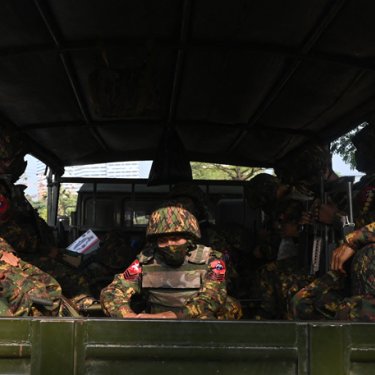The story of how press freedom was crushed in six months in Myanmar

Six months after a coup d’état in Myanmar on 1 February that put paid to a ten-year-old transition to democracy and an emerging free press, Reporters Without Borders (RSF) retraces the various stages by which the junta harassed, threatened and intimidated journalists and brought the press freedom situation to its current dire state.
The situation has been worsening steadily. According to figures verified by RSF, 43 journalists are currently held in Myanmar’s prisons. In all, 98 have been arrested in the past six months. The immense majority are being prosecuted under article 505(a) of the criminal code, under which spreading “fake news” is punishable by three years in prison. Dozens of other journalists are working clandestinely or have fled the country in order to continue covering the story from abroad.
What follows is the story of the six months of persecution that allowed Myanmar’s generals to crush the free press.
February 2021: Shock and crackdown
After the coup d’état, Myanmar’s journalists served as mouthpieces of the people, who staged demonstrations throughout the country in a show of hostility to the new military government. The journalists quickly found themselves the targets of a brutal crackdown.
1 February: The army’s tanks spread out across the streets of the capital, Naypyidaw. Like other members of the government elected in November 2020, information minister Pe Myint was arrested. The new military junta, led by Gen. Min Aung Hlaing, began trying to impose its own narrative.
4 February: Now under military control, the information ministry blocked Facebook, Twitter and Instagram.
9 February: A reporter was arrested while covering anti-junta protests in Mandalay, Myanmar’s second largest city. He was the first journalist to be officially arrested by the new military government.
14 February: The State Administration Council (SAC), as the military government calls itself, announced several regulatory reforms, including an amendment to article 505(a) of the penal code making comments that “cause fear” or spread “false news” punishable by three years in prison. The SAC also published a decree prohibiting the use of the terms “coup,” “junta” and “regime.”
26-28 February: The police carried out targeted raids against journalists, arresting 17 of them. Some were picked up from their homes.
March-April 2021: Intimidation
Many journalists faced an insuperable dilemma. On the one hand, they believed they had a duty to cover the consequences of coup, especially the truly historic wave of protests it had triggered. On the other hand, they knew that the security forces were acting in such an arbitrary manner that they could be arrested for no other reason than the fact they were journalists and wanted to do their job. As a result, many began working clandestinely while others had to go into self-imposed exile.
8 March: The junta suspended the licences of five media outlets known for their editorial independence. Democratic Voice of Burma, 7 Day News, Khit Thit News, Mizzima and Myanmar Now no longer had the right to publish or broadcast news stories or post content on social media. One by one, all other media outlets that did not toe the line imposed by the generals ended up suffering the same fate.
15 March: The police forced detained journalists to sign statements undertaking to stop covering street demonstrations.
17 March: The junta announced a new decree under which the death sentence could be imposed for 23 crimes with no possibility of appeal. The crimes included violating the media law and spreading “fake news.”
4 April: A blacklist of journalists wanted for spreading information about the pro-democracy movement began being published daily in the state media. The military urged the public to inform on the targeted journalists.
May-June-July 2021: Consolidation
With all independent media neutralised and dozens of journalist in prison, the junta had achieved its initial goal of imposing terror. As Swe Win, the editor of the Myanmar Now website told RSF, “We are now at a point where continuing to do our jobs means risking being jailed or killed.” In June, the military began a new phase, one of consolidation.
12 May: Democratic Voice of Burma journalist Min Nyo was sentenced to three years in prison on a charge of “criminal mutiny” under article 505(a) of the penal code. He was the first journalist to be convicted by a military court since the 1 February coup.
24 May: US citizen Danny Fenster, the managing editor of the Frontier Myanmar news magazine, was arrested for no clear reason at Yangon airport as he was about to leave the country. After his completely arbitrary arrest, he has been held incommunicado for 25 days, before being charged under section 505a of Myanmar's penal code.
2 June: Aung Kyaw, a DVB reporter, and Zaw Zaw, a freelancer reporting for Mizzima News, were convicted by a military court in the southern city of Myeik. They were both sentenced to two years in prison under article 505(a) of the penal code.
30 June: In an operation clearly designed to improve the junta’s international image, state TV announced the release of several hundred prisoners, including six journalists, who had been arrested during protests. The mask fell less than two weeks later when some of the journalists were re-arrested. They included Ayeyarwady Times reporter Aung Mya Than, who was re-arrested on 10 July and was returned to prison.
20 July: Police arrested three women journalists in Taunggyi, the capital of the eastern state of Shan, on suspicion of publishing a clandestine media outlet called Than Lwin Thway Chin. Other small pockets of resistance like this media outlet have been crushed by the military steamroller all over the country. Journalism is being suffocated.
Myanmar is ranked 140th out of 180 countries in RSF's 2021 World Press Freedom Index.



